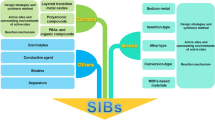The feasibility of using anodic depolarization for water electrolysis in a system containing a solid polymer electrolyte is examined. Anodic depolarization in electrolysis helps reduce energy consumption by a half. Sulfur dioxide (sulfurous anhydride) and some organic compounds, methanol in particular, can be used as depolarizers.



Similar content being viewed by others
References
S. A. Grigor’ev and D. G. Bessarabov, “Solid polymer electrolysis with anodic depolarization for hydrogen generation,” Transp. Alternat. Topl., No. 6 (30), 69–71 (2012).
E. Lee and A. Brecher, US Patent 3888750, Electrocatalytic Decomposition of Water, publ. 02.10.1975.
C. M. Hollabaugh, A. Bowman, and G. Melvin, US Patent 6244794, Hydrogen Production by the Decomposition of Water, publ. 07.31.1979.
R. Schulten, D. Behr, and S. Friedrich, US Patent 4059496, Process for the Preparation of Sulfuric Acid from Sulfur Dioxide, publ. 09.20.1976.
V. I. Kostin, V. N. Fateev, D. A. Bokach, et al., “Hydrogen and sulfuric acid production by electrolysis with anodic depolarization by sulfurous anhydride,” Khim. Neftegaz. Mashinostr., No. 3, 8–11 (2008).
A. V. Kozolii and V. I. Kostin, “Effect of pressure on the process of water electrolysis with anodic depolarization by sulfurous anhydride,” Elektrokhim. Energ., 10, No. 1, 34–37 (2010).
C. Lamy, E. M. Belgsir, and J-M Leger, “Electrocatalytic oxidation of aliphatic alcohols: Application to the direct alcohol fuel cell (DAFC),” J. Appl. Electrochem., 31, No. 7, 799–809 (2001).
D. Cao and S. H. Bergens, “A direct 2-propanol polymer electrolyte fuel cell,” J. Power Sources, 124, 12–17 (2003).
E. Peled, V. Livshits, and T. Duvdevani, “High-power direct ethylene glycol fuel cell (DEGFC) based on nanoporous proton-conducting membrane (NP-PCM),” J. Power Sources, 106, 245–248 (2002).
R. Parsons and T. Van der Noot, “Electrooxidation of methanol on noble metals surfaces,” J. Electroanal. Chem., 257, 9–15 (1988).
P. S. Kauranen, E. Scou, and J. Munk, “Kinetics of methanol oxidation on carbon-supported Pt and Pt + Ru catalysts,” J. Electroanal. Chem., 404, 1–13 (1996).
A. Hamnett, “Mechanism and electrocatalysis in the direct methanol fuel cell,” Catal. Today, No. 38, 445–457 (1997).
L. Carette, K. Friedrich, and U. Stimming, “Fuel cells – fundamentals and applications,” Fuel Cells, No. 1, –39 (2001).
Author information
Authors and Affiliations
Corresponding author
Additional information
Translated from Khimicheskoe i Neftegazovoe Mashinostroenie, No. 9, pp. 7–8, September, 2013.
Rights and permissions
About this article
Cite this article
Kostin, V.I., Grigor’ev, S.A., Bessarabov, D.G. et al. Hydrogen Generation by Solid Polymer Electrolysis with Anodic Depolarization. Chem Petrol Eng 49, 575–578 (2014). https://doi.org/10.1007/s10556-014-9797-x
Published:
Issue Date:
DOI: https://doi.org/10.1007/s10556-014-9797-x




